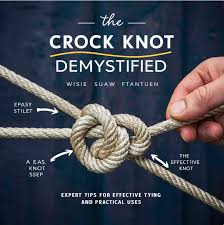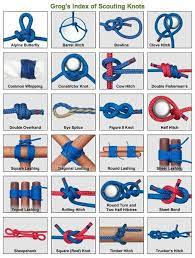The crock knot is a flexible and reliable knot widely applied in several packages, from outdoor sports like tenting and hiking to ordinary obligations that require regular fastening. Known for its simplicity and power, the crock knot is crucial for all interested in knot-tying. In this complete manual, we can discover the intricacies of the crock knot, its use, the way to tie it, and hints to
ensure its effectiveness.
Table of Contents
Understanding the Crock Knot
The crock knot is characterized by using its capacity to create a stable and adjustable loop. This makes it particularly beneficial in conditions in which the tension wants to be adjusted without untying the knot completely. Unlike other knots that might slip under stress, the crock knot keeps its maintenance, providing reliability in several situations.
Key Features of the Crock Knot
Versatility:
The crock knot can be carried out in diverse applications, from securing hundreds to putting in area tents.
Adjustability:
One of the crock knot’s standout capabilities is its effortless adjustment, which allows for remarkable tension tuning.
Security:
When tied efficaciously, the crock knot holds the enterprise and does not slip, making it a dependable preference for important programs.
Simplicity:
Despite its effectiveness, the crock knot is handy to tie, making it suitable even for beginners.
Applications of the Crock Knot
The crock knot is rather versatile and is utilized in several conditions. Here are a number of the
most common applications:
Camping and Hiking
In tenting and trekking, the crock knot is beneficial for installing region tents, securing tarps, and placing hammocks. Its adjustability allows short modifications to the setup, ensuring stability and luxury in several environments.
Climbing and Rescue Operations
Climbers and rescue personnel often use the crock knot due to its reliability and ease of adjustment. It can create steady ropes, harnesses, and anchor elements for installation. The knot’s potential to preserve under tension without slipping is critical in excessive-stakes situations.
Sailing and Boating
The crock knot is used for regular sails, tie-down tools, and control lines in sailing and boating. Its resistance to slipping makes it best for handling dynamic and often unpredictable situations at sea.
Everyday Use
Beyond specialized sports, the crock knot is beneficial in regular situations. It may be used for tying bundles, securing vehicle masses, or restoring broken shoelaces quickly. Its simplicity and reliability make it a go-to knot for numerous duties.


How to Tie the Crock Knot
Tying the crock knot is simple, and it can be mastered quickly with a bit of exercise. Follow these steps to tie the crock knot:
Start with a Loop:
Begin by developing a loop with the operating end of the rope. Ensure that the loop is sizeable enough for the intended software program program.
Pass the Working End:
Take the rope’s walking stop and pass it through the loop from below.
Wrap Around the Standing End:
Wrap the operating give-up throughout the popularity of part of the rope, developing an entire turn.
Create a Second Loop:
Pass the going-for-walks forestall once more via the specific loop, growing a 2d loop.
Tighten the Knot:
Pull on the reputation stop of the rope while keeping the walking stop to tighten the knot. Adjust the loops as needed to achieve the preferred tension.
Secure the Knot:
The crock knot must be preserved securely once tightened. Double-took on the knot to make sure its miles had been nicely tied and couldn’t slip underneath the load.
Tips for Effective Use of the Crock Knot
To make sure the crock knot is robust and dependable, follow the following tips:
Practice Makes Perfect:
Tie the crock knot numerous times to familiarize yourself with the
steps and ensure you can tie it quickly and efficiently. Check the Knot: Always double-check the knot to ensure it’s far stable after tying it. A poorly tied knot can fail under strain.
Use Quality Rope:
The rope’s outstanding will affect the knot’s overall performance. Use ropes that are appropriate for the intended software program and in the top scenario.
Understand Load Limits:
Be aware of the rope and knot’s burden limits. Overloading can cause the knot to fail, which is extremely important for preventing injuries or damage.
Conclusion
The crock knot is flexible and reliable, which is important for several programs, from camping and mountain climbing to everyday duties. Its simplicity, adjustability, and safety make it a precious talent to master. By recording a manner of tying and using the crock knot effectively, you’re organized for an extensive range of situations that require solid fastening.